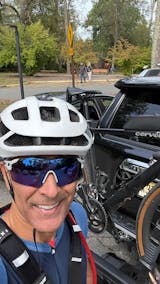Sunglasses for Low-Light Conditions

As fall flows into winter and then onto spring, short, cloudy, gray days become the norm. You may think this means there’s no reason to don a pair of sunglasses, but today’s optics beg to differ. An entire family of specialty lenses can help you see better in flat light to no light. For cyclists, runners, cross-country skiers, and other active sports types, specialized low-light lenses can cut glare and protect your eyes from grit, rain, snow, and wind. Below is a handy guide to finding the perfect low-light lens options for your lifestyle and sport.
Sports That Need Low-Light Glasses
Cloudy days that reduce or block shadows from forming on uneven terrain, snow, or road surfaces can be a hazard. An athlete’s inability to correctly read the terrain in front of them can lead to a fall or worse. Any downhill skier or snowboarder who’s experienced the problem firsthand wears their ski goggles on those days. But the advantages extend beyond snow sports. Cyclists, runners (both street and trail runners), and even car drivers and motorcycle riders will all benefit from the improved clarity, contrast, and safety of low-light sunglasses.
Best Sunglasses Lens Tints for Low Light
The classic lens tint color choice for flat light is yellow. Hunters have worn yellow-tinted glasses for years to help them better spot birds against the backdrop of a cloudy fall morning. While Rudy Project offers yellow spare lenses for select eyewear models, the Racing Red and ImpactX Photochromic 2 Red lenses are excellent for boosting contrast and sharpness, making them ideal for darker dawn or dusk scenarios or any match taking place under the lights of a tennis court or outdoor hockey rink.
Sunglasses lens tints are rated by Light Transmission Value (LTV). The higher the percentage, the more light filters through the lens. For example, Rudy Project’s Grey Laser lens only lets in 10.8% of light, making it one of the darkest lenses available from Rudy Project. Conversely, Rudy Project’s Photochromic 2 Red Running Lenses let in up to 76% of light. At first glance, they look almost tint-free. A good rule of thumb: If you’re active after dark, try lenses with LTVs of 50% or higher.
Those of you cycling, running, skiing, or skating under the lights at night should also consider a lens with an anti-reflective coating on the lens. This coating will reduce eye strain and cut the glare spots from oncoming cars and overhead floodlights.
Photochromic Lenses for Every Condition
The easiest solution to finding the perfect sunglasses for every light level — even night — is to go with a pair of photochromic lenses. The more natural light hits the lens, the darker they become, and in the absence of natural light, the sunglasses turn almost transparent. And the transition happens in mere seconds. Rudy Project’s extensive selection of photochromic lenses in various tints means you don’t have to give up the high-contrast, sharper vision offered by the yellow, amber, or rose tints above. For an example, see the Photochromic 2 Red Running Lenses mentioned earlier.
Even as the days grow a little darker this winter, you can see better with a premium pair of low-light sunglasses. It may sound like an oxymoron, but it’s true. See for yourself.









